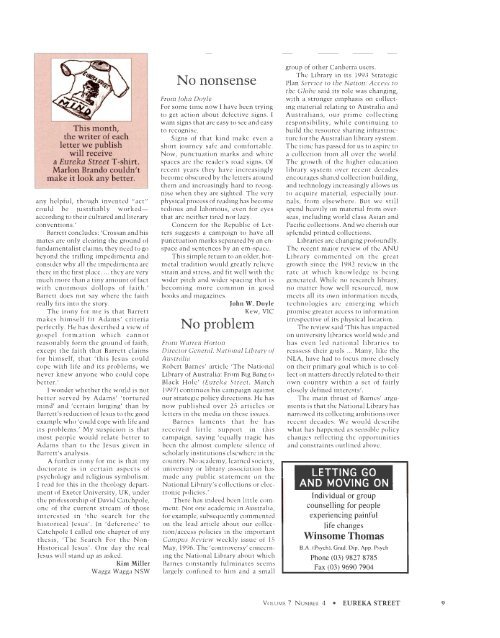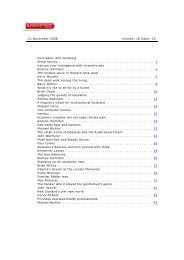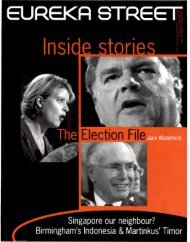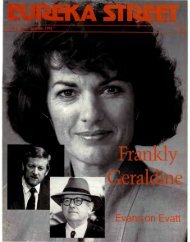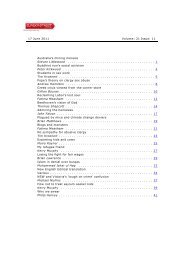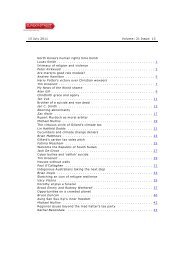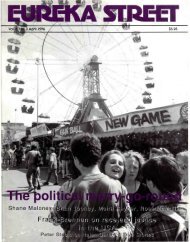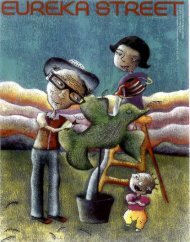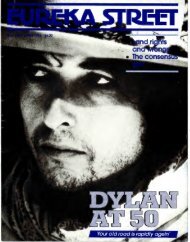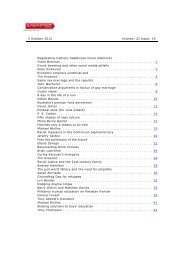n - Eureka Street
n - Eureka Street
n - Eureka Street
Create successful ePaper yourself
Turn your PDF publications into a flip-book with our unique Google optimized e-Paper software.
This month,the writer of eachletter we publishwill receivea <strong>Eureka</strong> <strong>Street</strong> T -shirt.Marlon Branda couldn'tmake it look any better.any he lpful, though invented "act"could be justifiably workedaccordingto their cultured and literaryconventions.'Barrett concludes: 'Crossan and hismates are only clearing the ground offundamentalist claims; they need to gobeyond the trifling impedimenta andconsider why all the impedimenta arethere in the first pl ace . ... they are verymuch more than a tiny amoun t of factwith en ormou s dollops of faith.'Barrett does not say where the faithreally fits into the story.The irony for m e is that Barrettmakes h imself fit Adams' criteriaperfectly. H e h as described a view ofgospel form a tion whic h canno treasonably form the ground of faith,except the faith that Barrett claimsfor him self, th at ' this Jesus couldcope with life and its problem s; wenever knew anyone who could copebetter. 'I wonder whether the world is notbetter served by Adams' ' torturedm ind' and 'certain longing' than byBarrett's reduction of Jesus to the goodexample who 'could cope with li fe andits problems.' M y suspicion is thatm ost people would relate better toAdam s than to the Jesu s given inBarrett's analysis.A further irony for m e is that m ydoctorate is in certain aspects ofpsychology and religious symbolism .I rea d fo r this in the theology department of Exeter University, UK, underthe professorship of David Catchpole,one of the current stream of thoseinterested in ' the search for thehistorical Jesu s'. In 'deference' toCatchpole I called one chapter of m ythesis, 'The Search For the NonHistorical Jesus'. One da y the realJesus will stand up as asked.Kim MillerWagga Wagga NSWNo nonsenseFrom fohn DoyleFor some time now I have been tryingto get action about defective signs. Iwant signs that are easy to see and easyto recognise.Signs of th at kind make even ashort journey safe and comfortable.N ow, punctuation m arks and whitespaces are the reader's road signs. Ofrecent years they have increasinglybecom e obscured by the letters aroundthem and increasingly hard to recognisewhen they are sighted. The veryphysical process of reading has becometedious and laborious, even for eyesthat are neither tired nor lazy.Concern for the Republic of Letterssuggests a campaign to h ave allpunctuation marks separated by an enspaceand sentences by an em -space.This simple return to an older, hotmetaltradition would greatly relievestrain and stress, and fit well w ith thewider pitch and wider spacing that ibecoming m ore common in goodbooks and m agazines.John W. DoyleKew, VICNo problemFrom Warren HortonDirector General, National Library ofA ustraliaRobert Barnes' article 'The N ationalLibrary of Au tralia: From Big Bang toBlack Hole' (Eu reka <strong>Street</strong>, March1997) continues his ca mpaign againstour strategic policy directions. He hasn ow publish ed over 25 articles orletters in the m edia on these issues.Barnes lam ents that h e hasreceived little support in thiscampaign, saying 'equally tragic hasbeen the almost complete silence ofscholarly institutions elsewhere in thecountry. N o academy, learned society,university or library association hasm ade any public statem ent on theN ational Library's collections or electronicpolicies.'There has indeed been little com ment. N ot one academic in Australia,for example, subsequently commentedon the lea d article about our collection/accesspolicies in the importantCampus Review weekly issu e of 15May, 1996. The 'controversy' concerningthe National Library about whichBarnes constantly fulminates seemslargely confined to him and a smallgroup of other Canberra users.The Library in its 1993 StrategicPlan Service to the Nation: Access tothe Globe said its role was changing,with a stronger emphasis on collectingmaterial relating to Australia andAustralians, o ur prime collectingresponsibility, w hile continuing tobuild the resource sharing infrastructurefor the Australian library system.The time has passed for us to aspire toa coll ection from all over the world.The growth of the higher educationlibrary system over recent decadesencourages shared collection building,and technology increasingly allows usto acquire m aterial, especially journals,from elsewhere. But we stillspend heavily on m aterial from overseas,including world class Asian andPacific collections. And we cherish oursplendid printed collections.Libraries are changing profoundly.The recent major review of the ANULibra ry commented on the greatgrowth since the 1982 review in thera te a t which knowledge is beinggenerated. While no research library,no m atter how well resourced, nowm eets all its own information needs,technologies are em erging whichpromise greater access to informationirrespective of its physical location.T he review said 'This has impactedon university libraries world wide andh as even led na tiona! libraries toreassess their goals .. . Many, like theNLA, have had to focus more closelyon their primary goal which is to collecton matters directly related to theirown country w ithin a set of fairlyclosely defined interests'.The main thrust of Barnes' arguments is that the National Library hasnarrowed its collecting ambitions overrecen t decades. We w ould describewhat has happened as sensible policychanges refl ecting the opportunitiesand constraints outlined above.LETTING GOAND MOVING ONIndividual or groupcounselling for peopleexperiencing painfullife changesWinsome ThomasB.A . (Psych), Grad. Dip. App. PsychPhone (03) 9827 8785Fax (03) 9690 7904V OLUME 7 N UMBER 4 • EUREKA STREET 9


